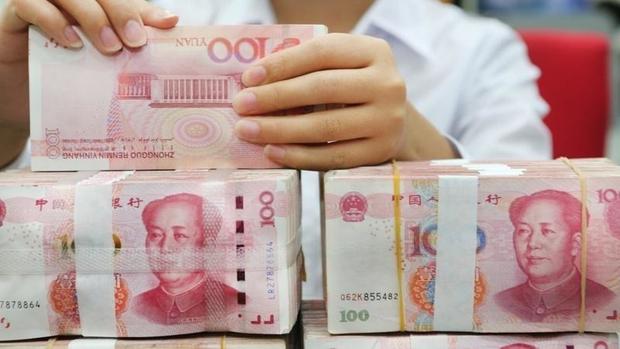 In this July 23, 2018 photo, a Chinese clerk counts yuan banknotes at a branch of Bank of China in Nantong city, East China's Jiangsu province. (PHOTO / IC)
In this July 23, 2018 photo, a Chinese clerk counts yuan banknotes at a branch of Bank of China in Nantong city, East China's Jiangsu province. (PHOTO / IC)
China is expected to maintain stable macroeconomic policies this year with optimized structural support to strengthen its economic rebound amid lingering external challenges, according to economists and policy advisers.
With the annual two sessions approaching, markets are closely watching how the nation will calibrate its fiscal and monetary policies when the country's top legislature and top political advisory body meet.
Headline policy targets such as annual GDP growth, the fiscal deficit, inflation and employment will be unveiled at the meetings, which come at a critical juncture as China pursues high-quality development.
Achieving stable, sustainable economic growth will be vital for the nation this year.
In October, the 20th National Congress of the Communist Party of China determined that the coming five years will be crucial for getting the country's efforts to build a modern socialist country in all respects off to a good start.
For the Chinese economy to sail through external headwinds, experts said the nation's macroeconomic policies are expected to extend steady support for economic growth — avoiding either sharply tightening policy stance or overstimulating the economy
At home, China has entered a new phase of COVID-19 containment, with increased population mobility and consumer activity. Fine-tuning policy regarding the real estate sector and platform enterprises has added confidence to economic recovery.
However, external challenges remain as global economic downward risks mount. Experts caution that this station could lead to negative growth in China's exports. Risks also linger regarding geopolitical tensions, supply chain fragmentation and interest rate rises in the United States.
For the Chinese economy to sail through these external headwinds, the experts said the nation's macroeconomic policies are expected to extend steady support for economic growth — avoiding either sharply tightening policy stance or overstimulating the economy.
While the overall strength of macroeconomic policies may be kept stable and moderate, they said the structure of support will likely be optimized to spur a consumption-led recovery and accelerate economic upgrading to increase the country's potential for high-quality development.
Robin Xing, Morgan Stanley's chief China economist, said, "Macroeconomic policies are expected to stay relatively accommodative throughout this year to ensure a steady economic recovery from COVID-19 without a sharp tightening of policy stance."
ALSO READ: Digital China seen spurring economy
In the run-up to the two sessions, the country's leadership vowed at the tone-setting Central Economic Work Conference in December that proactive fiscal policy and prudent monetary policy would continue to be implemented this year.
At the meeting, it was decided to place the focus on boosting domestic demand by prioritizing the recovery and expansion of consumption, while underlining moves to improve public expectations and boosting confidence for development.
A detailed macroeconomic policy agenda in line with these priorities is expected to be announced at the two sessions, which may set the GDP growth target for this year at more than 5 percent, or about 5.5 percent year-on-year, up from last year's GDP expansion of 3 percent, the experts said.
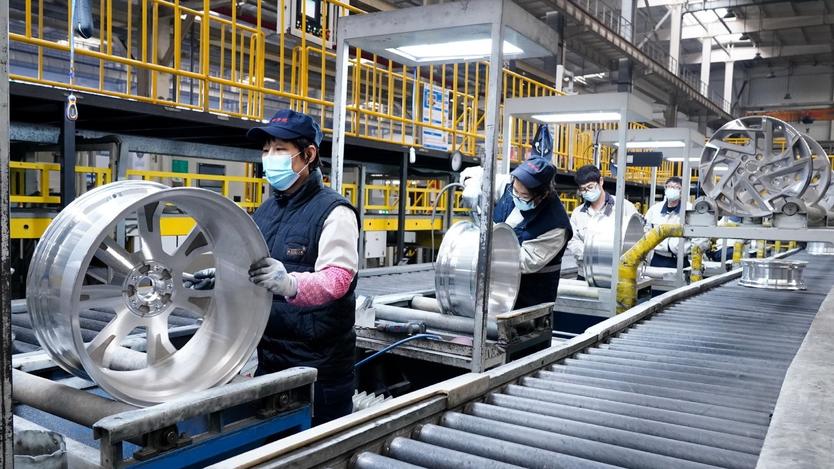 Employees work at a wheel company in Qinhuangdao, Hebei province, Feb 2, 2023. (PHOTO / XINHUA)
Employees work at a wheel company in Qinhuangdao, Hebei province, Feb 2, 2023. (PHOTO / XINHUA)
Zhu Haibin, JPMorgan's chief China economist, said the nation's budget deficit-to-GDP ratio may be raised to about 3 percent as an expansionary fiscal policy is maintained this year, although the overall strength of fiscal support may edge down from last year
Signaling a proactive fiscal stance, the nation may raise its deficit-to-GDP ratio — the shortfall in a government's income compared with its spending as a percentage of GDP — from 2.8 percent last year to about 3 percent or even slightly higher at the two sessions, they said.
While a deficit-to-GDP ratio of 3 percent is traditionally considered a technical red line, the experts said it is unreasonable to rigidly adhere to the 3 percent rule as long as China's economic growth is sufficiently fast to pay for the deficit.
Su Jingchun, an associate researcher at the Chinese Academy of Fiscal Sciences, or CAFS, said: "I do not see 3 percent as a line in the sand. When macroeconomic conditions permit, increasing the deficit ratio can actually generate positive outcomes in economic activities."
Zhu Haibin, JPMorgan's chief China economist, said the nation's budget deficit-to-GDP ratio may be raised to about 3 percent as an expansionary fiscal policy is maintained this year, although the overall strength of fiscal support may edge down from last year.
Consumption focus
Compared with last year, when COVID-19 control measures, infrastructure investment, and tax refunds and cuts for businesses dominated China's fiscal expansion, fiscal policy this year may feature increased direct support for consumption, Zhu said.
He added that in contrast to the previous policy focus of providing aid for businesses, it is advisable for China to directly support consumers this year, because business-oriented stimulus measures could face obstacles in driving employment and wage growth as external demand weakens.
"If domestic demand cannot be fully unleashed while external demand sours, the goods produced by companies may not sell, making companies unwilling to increase investment, expand production and hire more employees," Zhu said.
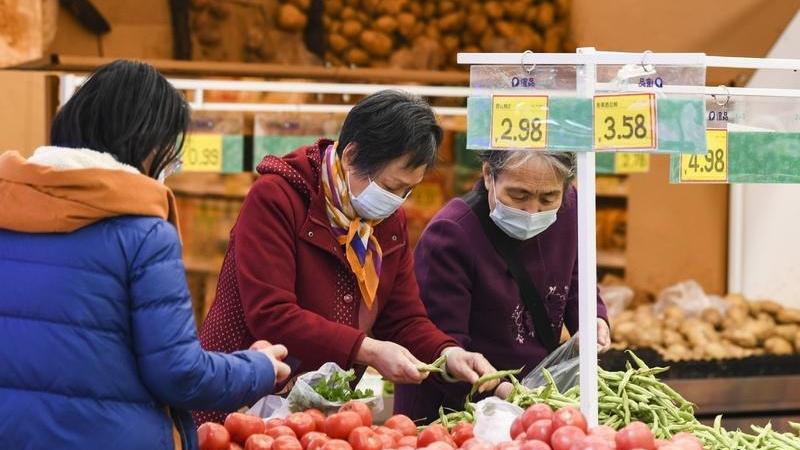 Customers buy groceries at a supermarket in Chongqing, on Dec 2, 2022. (PHOTO / XINHUA)
Customers buy groceries at a supermarket in Chongqing, on Dec 2, 2022. (PHOTO / XINHUA)
Cheng Shi, chief economist at ICBC International, said it is reasonable to increase the number of items eligible for personal income tax deductions to raise consumers' disposable income, adding that measures to tap the rising spending power of rural residents may also be on the way
Data from the National Bureau of Statistics, or NBS, show exports of goods fell by 0.5 percent in China year-on-year to 2.16 trillion yuan ($310 billion) in December, indicating the downside risk facing external demand.
Zhu said direct support for consumers can help "start the engine of policy transmission", adding that consumption stimulus for specific sectors, including big-ticket items such as home appliances and automobiles, is likely to be announced at the two sessions.
ALSO READ: Urbanization to be major growth driver
A less likely but still advisable option would be to provide nationwide cash subsidies or consumption vouchers, including those in the form of the digital yuan, or e-CNY, to low- and middle-income households, whose income levels were hit by the pandemic, Zhu said.
With the rate at which consumers save falling, the contribution of consumption to China's GDP growth this year — which is forecast to reach 5.6 percent — may rise to 4.1 percentage points, up from 1 percentage point last year, Zhu added.
A consumption rebound has already started. Sales revenue of consumption-related industries during the Spring Festival holiday, which ended in late January, rose by 12.2 percent from a year earlier, and by 12.4 percent compared with the same period in 2019, the State Taxation Administration said.
Cheng Shi, chief economist at ICBC International, said it is reasonable to increase the number of items eligible for personal income tax deductions to raise consumers' disposable income, adding that measures to tap the rising spending power of rural residents may also be on the way.
While consumption will emerge as a major driver of growth this year, the experts called for policy efforts to maintain resilient growth in investment, which is key to expanding consumption while setting the stage for future expansion.
Xing, from Morgan Stanley, said this year's quota of local government special bonds — a key funding source for infrastructure construction — may be expanded modestly, but not aggressively, at the two sessions, underpinning annual growth in infrastructure investment of about 10 percent.
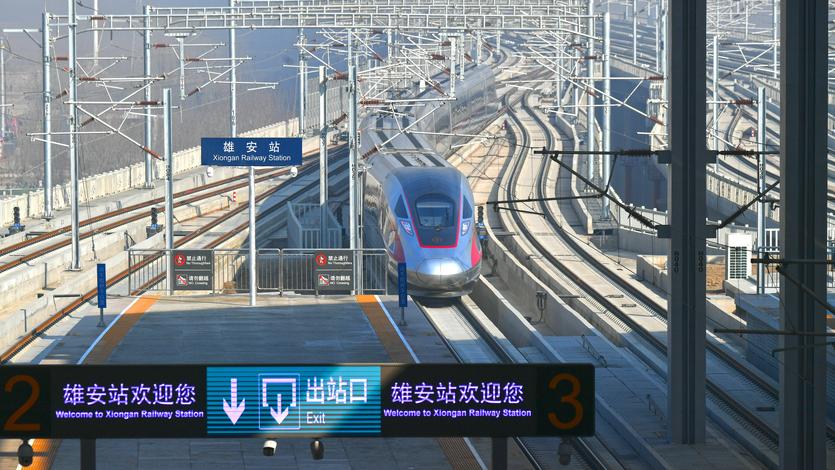 A Fuxing model high-speed train enters the Xiong'an Railway Station, Hebei, in December 2020. (SUN LIJUN / FOR CHINA DAILY)
A Fuxing model high-speed train enters the Xiong'an Railway Station, Hebei, in December 2020. (SUN LIJUN / FOR CHINA DAILY)
Property development is expected to stabilize as policy adjustments filter through, helping this year's combined fixed-asset investment growth in property and infrastructure rise to about 4 percent year-on-year, Xing added.
Last year, while government-led infrastructure investment registered a buoyant 9.4 percent growth, property development investment fell by 10 percent and fixed-asset investment made by the private sector — mainly composed of smaller businesses — only expanded by 0.9 percent, the NBS said.
ALSO REAd: Nod for China's 109 fixed-asset investment projects in 2022
There is still room for cutting interest rates to spur investment, reduce household costs and ease the government's ability to service debt, said Zhang Bin, a member of the National Committee of the Chinese People's Political Consultative Conference
Su, from CAFS, said that to facilitate the growth of smaller businesses and anchor market expectations, the scale of tax and fee cuts this year will likely be held steady compared with last year, with a focus on securing the operation of market players.
Zhang Bin, a member of the National Committee of the Chinese People's Political Consultative Conference, said, "The biggest challenge facing China's recovery is the lukewarm momentum of private investment — a key determinant of growth in employment, income and consumption."
Monetary support
There is still room for cutting interest rates to spur investment, reduce household costs and ease the government's ability to service debt, said Zhang, who is also deputy director of the Chinese Academy of Social Sciences' Institute of World Economics and Politics.
Cheng, from ICBC International, agreed that an interest rate cut could be adopted this year if economic growth needs to be consolidated, but he expects overall interest rate levels to remain stable to maintain steady support for the real economy.
Structural monetary tools, such as a targeted reduction in the reserve requirement ratio, are expected to be further used to support key areas and optimize economic structure, Cheng added.
With monetary policy to be held steady, experts said the two sessions may, like last year, set a target for social financing growth to be generally on par with nominal GDP growth, while the annual inflation target may also remain unchanged at about 3 percent.
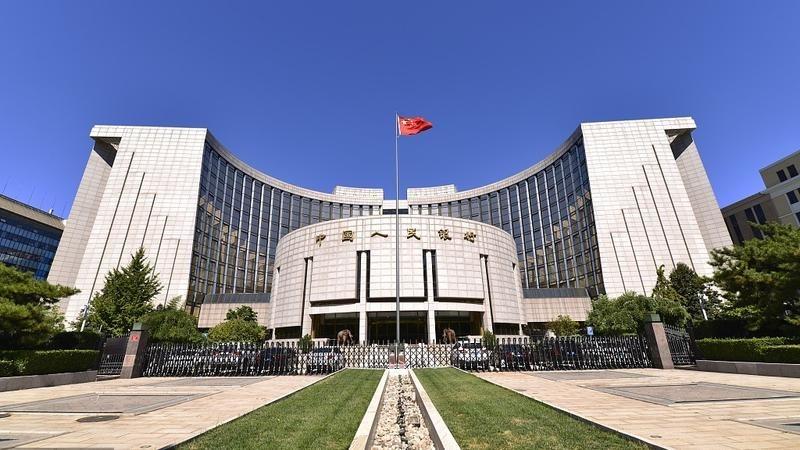 This file photo dated Sept 28, 2018 shows the headquarters of the People's Bank of China, the central bank, in Beijing. (PHOTO / VCG)
This file photo dated Sept 28, 2018 shows the headquarters of the People's Bank of China, the central bank, in Beijing. (PHOTO / VCG)
With monetary policy to be held steady, experts said the two sessions may, like last year, set a target for social financing growth to be generally on par with nominal GDP growth, while the annual inflation target may also remain unchanged at about 3 percent
This forecast is in line with the latest monetary policy report from the People's Bank of China, which on Friday vowed to ensure stable, sustainable support for the real economy, maintain effective credit growth, and heed changes in inflation.
READ MORE: PBOC: China's monetary policy to boost domestic demand
Structural monetary tools will focus on providing reasonable, moderate support for key areas such as inclusive finance, technological innovation and green development, the report said.
Joong Shik Kang, deputy mission chief for China at the International Monetary Fund's Asia and Pacific Department, said further monetary accommodation and neutral fiscal policy are necessary for China, and such policies can help protect the nation's consumption-led recovery from the risks of slowing global growth and real estate weakness.
"The recovery is good news not only for China, but for the rest of the world," he said.
IMF estimates suggest that for every percentage point of higher growth in China, activity in other economies rises on average by 0.3 percentage point, with those economies with deeper trade links with China benefiting the most.


